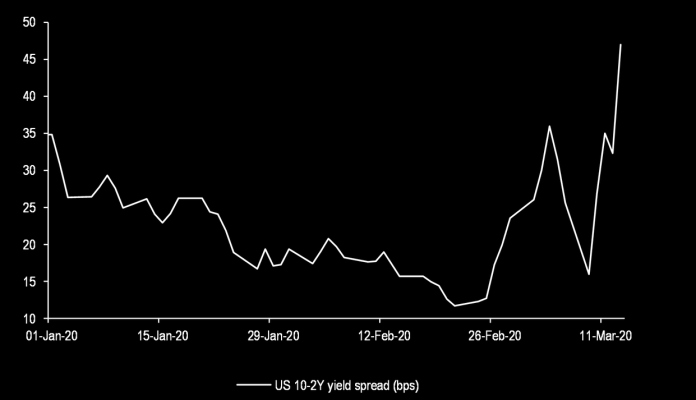Kind Reminder:
In our introduction to yield curves, we noted that the idea behind the use of a Yield Curve is to measure investors’ perception of risk and future developments both in the bond market as well as in the overall economy. Short-term bonds should carry lower yields than longer-term ones because lending to someone for a shorter period of time is less risky for the investor. As such, Yield Curves should be positive.
This behaviour is referred to as the normal yield curve, which slopes upward from left to right on the graph as maturities lengthen and yields rise. This is the usual case in most instances throughout history.
However, there are times when the yield curve becomes steeper, inverted or flatter.
Inverted Yield Curve: In periods preceding recessions, the yield curve can actually invert, with short-term bonds offering higher yields than longer-term bonds. While this appears to be counterintuitive, there is a reason this makes sense: given that lower economic growth means lower yields then bond investors seek the safety of longer-term assets for their funds. As such, demand for these bonds increases and yields decline. Given that lower yields are associated with lower interest rates and lower interest rates are usually associated with slower economic growth, an inverted yield curve is often taken as a sign that the economy may soon stagnate.
However, since the last few days we have seen is US but also in Europe bonds, composing a steep yield curve, we decided to have this article and podcast in order to explain the other two types of Yield curve.
Last night, Wall street continued to firm up on optimism the virus might be plateauing, or that at least that the worst has been seen. With that in mind, there’s increasing hope the lockdowns might be ended sooner rather than later. Stock markets post some gains while Treasuries were mixed. Hence, the long end continued to underperform and steepening the curve out to 50 bps. But what does a steep yield curve means?
Steep yield curve is when the difference between the long-term and short-term bonds becomes larger. This usually occurs at the beginning of a period of economic expansion, following the end of a recession. At that point, short-term interest rates will likely be very low given that the Central Bank has lowered them to fight the recession. However, as the economy begins to grow again, many people believe that inflation will also follow suit. At this point long-term bond investors fear that they will be locked into low rates as a result of the until-then depressed rates. As a result, they demand higher rates and only commit to their funds if the long-term bonds increase their yields.
A steepening yield curve typically indicates that investors expect rising inflation and stronger economic growth.
What is a Flat Yield Curve?
Flat yield curve meanwhile, is slightly the opposite of Steep Yield curve.
A flattening yield curve is when the difference between the long-term and short-term bonds becomes smaller and smaller – curve becomes less curvy -flat. At this point, investors demand higher long-term rates to make up for the lost value because inflation reduces the future value of an investment. A flattening yield curve can also occur in anticipation of slower economic growth. Sometimes the curve flattens when short-term rates rise on the expectation that the Central Bank will raise interest rates.
This happens because rising interest rates cause bond prices to go down—when fixed-rate bond prices fall, their yields rise.
Editors’ Picks

GBP/USD runs beyond 1.3400 on BoE, US CPI
The GBP/USD pair jumped towards the 1.3440 area on Thursday, following the Bank of England decision to cut rates, and US CPI data, which resulted much softer than anticipated. The pair holds on to substantial gains early in the American session.

EUR/USD ticks north after ECB, US inflation data
The EUR/USD pair hovered around 1.1750 but is still unable to conquer the price zone. The European Central Bank left interest rates unchanged, as expected, upwardly revising growth figures. The US CPI rose 2.7% YoY in November, down from the 3.1% posted in October.

Gold nears $4,350 after first-tier events
The bright metal advances in the American session on Thursday, following European central banks announcements and the United States latest inflation update. XAU/USD approaches weekly highs in the $4,350 region.

Crypto Today: Bitcoin, Ethereum hold steady while XRP slides amid mixed ETF flows
Bitcoin eyes short-term breakout above $87,000, underpinned by a significant increase in ETF inflows. Ethereum defends support around $2,800 as mild ETF outflows suppress its recovery. XRP holds above at $1.82 amid bearish technical signals and persistent inflows into ETFs.

Bank of England cuts rates in heavily divided decision
The Bank of England has cut rates to 3.75%, but the decision was more hawkish than expected, leaving market rates higher and sterling slightly stronger. It's a close call whether the Bank cuts again in February or March.
RECOMMENDED LESSONS
Making money in forex is easy if you know how the bankers trade!
I’m often mystified in my educational forex articles why so many traders struggle to make consistent money out of forex trading. The answer has more to do with what they don’t know than what they do know. After working in investment banks for 20 years many of which were as a Chief trader its second knowledge how to extract cash out of the market.
5 Forex News Events You Need To Know
In the fast moving world of currency markets where huge moves can seemingly come from nowhere, it is extremely important for new traders to learn about the various economic indicators and forex news events and releases that shape the markets. Indeed, quickly getting a handle on which data to look out for, what it means, and how to trade it can see new traders quickly become far more profitable and sets up the road to long term success.
Top 10 Chart Patterns Every Trader Should Know
Chart patterns are one of the most effective trading tools for a trader. They are pure price-action, and form on the basis of underlying buying and selling pressure. Chart patterns have a proven track-record, and traders use them to identify continuation or reversal signals, to open positions and identify price targets.
7 Ways to Avoid Forex Scams
The forex industry is recently seeing more and more scams. Here are 7 ways to avoid losing your money in such scams: Forex scams are becoming frequent. Michael Greenberg reports on luxurious expenses, including a submarine bought from the money taken from forex traders. Here’s another report of a forex fraud. So, how can we avoid falling in such forex scams?
What Are the 10 Fatal Mistakes Traders Make
Trading is exciting. Trading is hard. Trading is extremely hard. Some say that it takes more than 10,000 hours to master. Others believe that trading is the way to quick riches. They might be both wrong. What is important to know that no matter how experienced you are, mistakes will be part of the trading process.
The challenge: Timing the market and trader psychology
Successful trading often comes down to timing – entering and exiting trades at the right moments. Yet timing the market is notoriously difficult, largely because human psychology can derail even the best plans. Two powerful emotions in particular – fear and greed – tend to drive trading decisions off course.

